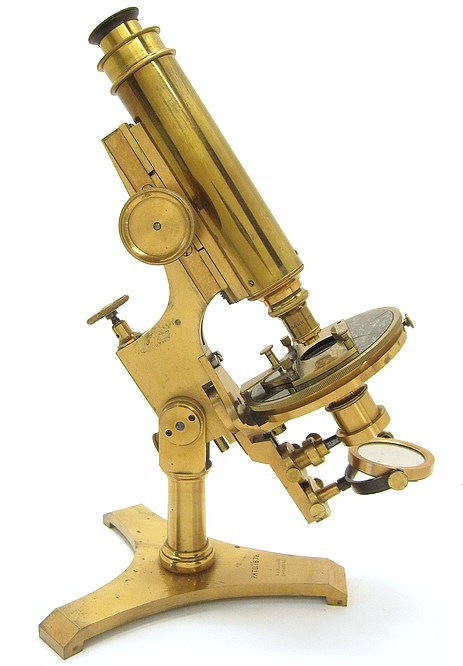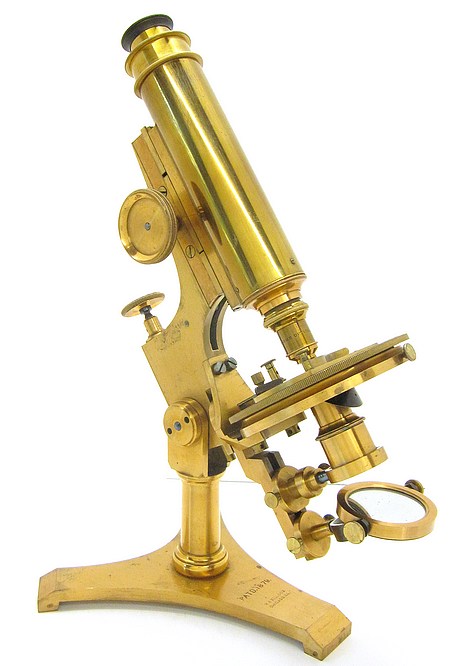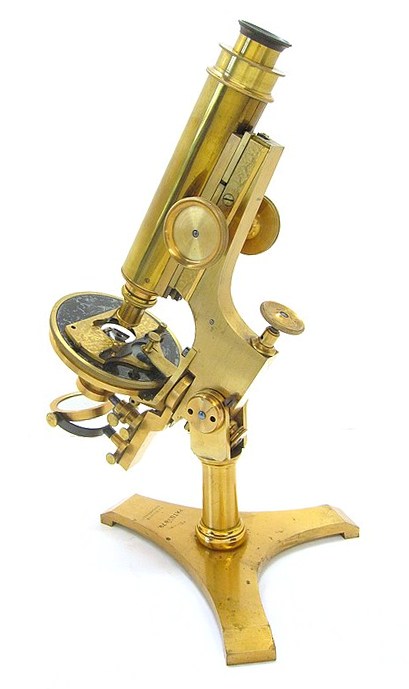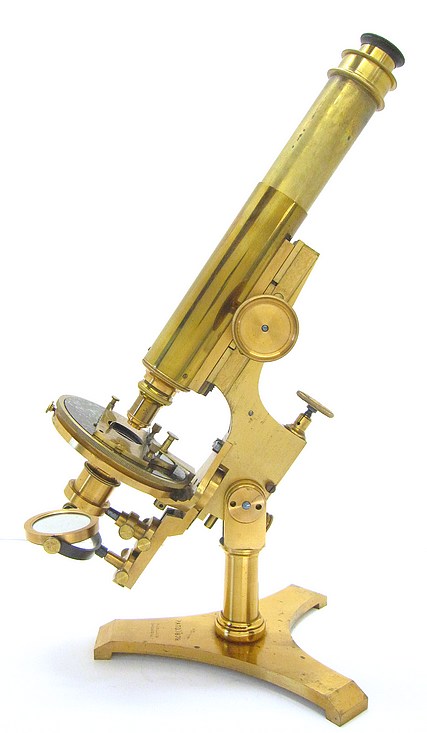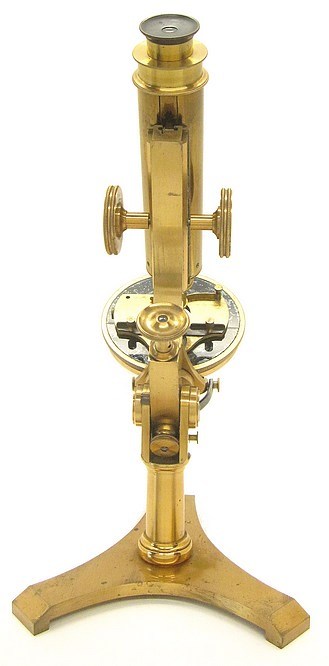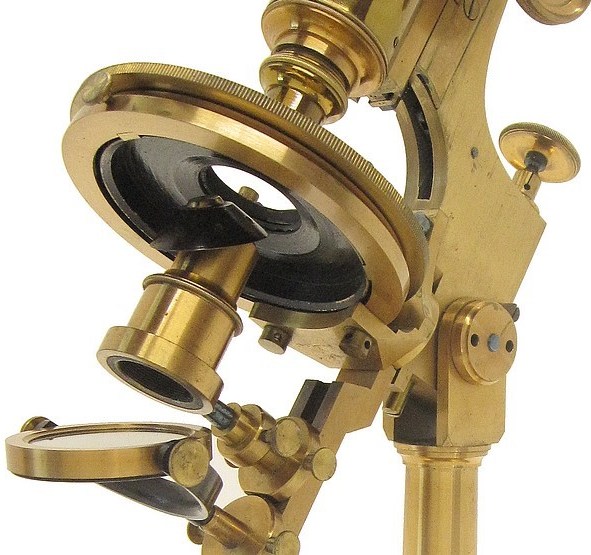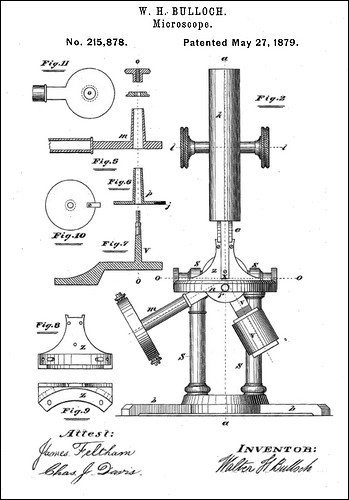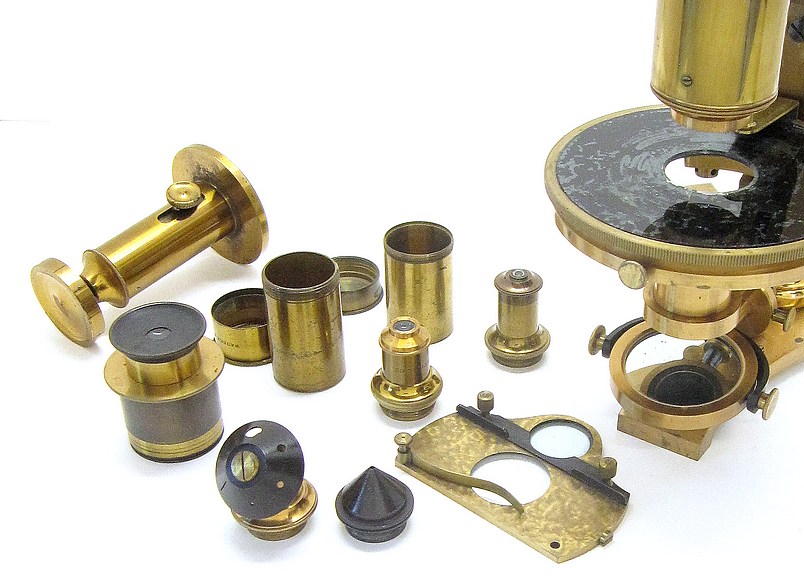
This microscope came out of an estate in Berwyn IL. It is without its storage case. Among the surviving accessories are two objectives, a W. Wales ⅕ and a Bausch & Lomb ½, each with a brass canister, one eyepiece, a cone diaphragm, a Gillett diaphragm, and a hand microtome. As shown in the photos inclined with the draw-tube closed, the microscope is about 12-inches in height. The microscope has a revolving glass stage with sliding object carrier.
The following description of the Histological Microscope was extracted from the 1890 Bulloch catalog:
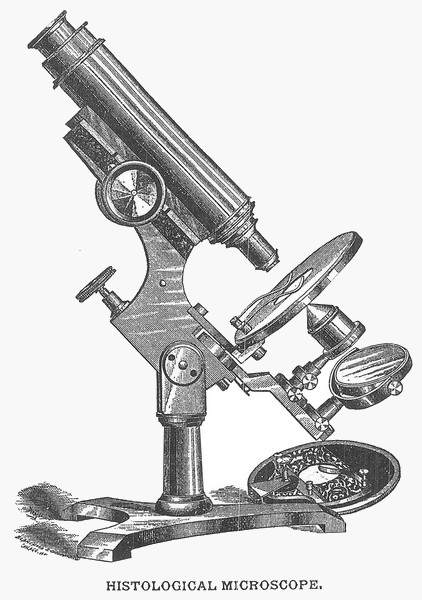
HISTOLOGICAL MICROSCOPE
(Patented 1879)
This instrument is similar in construction to the biological, except that the mirror and sub-stage on the histological stand are on a single bar. Plain and concave mirrors can be used over the stage in place of a bull's-eye con denser, and there is a spring click to indicate when the mirror bar is central with the axis of the tube. The sub-stage consists of an adapter, with society screw, in which an objective can be used for a condenser; and by means of a sliding stem and screw, it can be centered. The cone diaphragm is also fitted in the same adapter. The coarse adjustment is by rack and pinion; the fine adjustment, by micrometer screw, acting on a lever, moving the whole optical tube. The draw-tube has a ring marked for the standard length. There is an adapter in the draw-tube with the society screw, and the length of the optical tube is six inches; which tube is fitted with the broad-gauge and society screws. The stage has spring clips, for holding the object. Instrument is made entirely of polished brass.
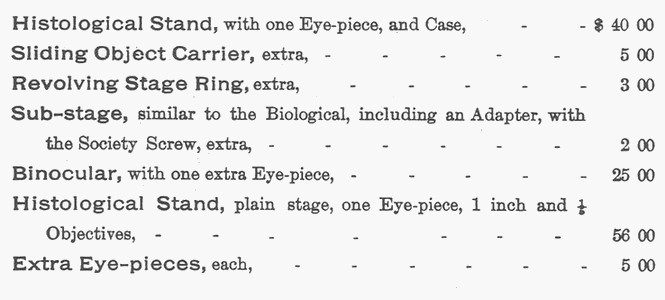
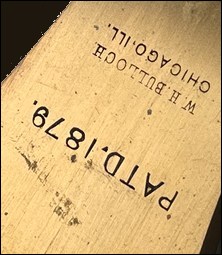
While the Bulloch signature and patent date is on the surface of the foot, it is marked on the underside of the foot with the serial number.
The Histological model is somewhat smaller than Biological No. 1 model and it has the mirror and sub-stage fitting on a single swinging arm.
Some of the unique features of this microscope are described in Bulloch's 1879 patent.
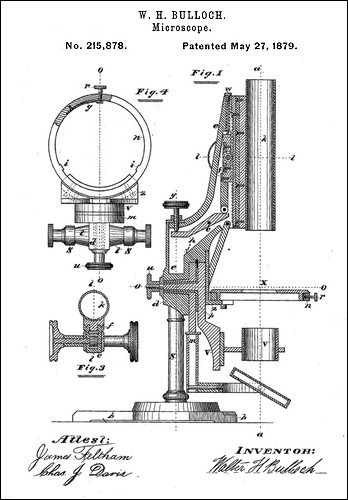
Obituary of Walter H. Bulloch published in the American Monthly Microscopical Journal, 1892:
Notice of Walter H. Bulloch.
By HENRY L. TOLMAN.
The death of this. eminent Chicago microscope maker is a severe loss, not only to the Illinois State Society.of which lie was for nearly twenty years n prominent member, but to the cause of science at large. He was born in I835, at Glasgow. Scotland, and lived there until he was seventeen years of age. About 1852 the family emigrated to New York, where Walter learned the trade of tailor with his father. But his innate fondness for mechanical pursuits made him dissatisfied with his
prospects, and he was apprenticed to Messrs. Pike & Sons, then a leading firm of opticians and instrument makers on Broadway. New York city. After serving his time he went into business until the war of the rebellion broke out, when he enlisted as a private in the 12th N. Y. volunteers. His term of service, however, was very short, as he contracted a severe cold, which developed into rheumatism, and he was incapacitated from further work, and was mustered out of service. Returning to New York he formed a
partnership with William Wales, the well-known maker of objectives, and continued in business there until 1866, when he moved to Chicago. He was very successful and had accumulated considerable means, when his shop and tools were destroyed in the memorable Chicago fire of Oct. 8 and 9, 1871. And Mr. Bulloch sustained a financial loss from which he never recovered. Immediately after this misfortune, he went to Boston and was for a time connected with the late R. B. Tolles, but again returned to establish himself
in Chicago. In 1889 he accepted a position connected with the U.S. Coast and Geodetic Survey in the Bureau of Weights and Measures, at Washington, but he chafed under the restraints of an official situation, and after six months experience, returned to his home here. Before he left his health had begun to fail, and after his return late in the fall of 1890 he suffered still more. But his indomitable perseverance led him to struggle on. He opened a place at No. 303 Dearborn
street, in a very advantageous business portion of the city, and began work again. It was not for long. After struggling with disease for about six months he was compelled to stop forever. He died Nov. 5. 1891. at Elgin IllL., where he had gone for treatment by Dr. IP. Tyrrell. He leaves a wife but no children.
Mr. Bulloch was a man of pronounced character and indomitable energy and perseverance. To those who did not know him well he appeared brusque and sometimes even overbearing. but his numerous friends soon learned to appreciate his straightforward manner of expressing his views, his pertinacious but just demands for a proper recognition of his rights, and his outspoken criticism of what he deemed erroneous in the theories or opinions of others. In his business he was conscientious and
painstaking to a fault. Often when making an instrument or piece of apparatus to order if he saw where time was room for improvement he would spend hours or days in experiments, perhaps wasting the results of all his previous labor, refusing to slight his work at any cost. Whether it was the simplest accessory or the finest microscope stand, nothing was allowed to leave his shop until it was as perfect as his trained hands could make it. His reputation was more than money, and he lived to see it world-wide. Besides
being a member of the Illinois State Microscopical Society, he was a member of the Chicago Academy of Sciences, the American Academy of Sciences, the American Society of Microscopists. and of the Royal Microscopical Society of London. His death leaves a gap in the rank of scientific workers which can not easily filled.
As of 2014, the highest known serial number for a Bulloch microscope was 675 suggesting that his output was much less than that for many other contemporary makers.
